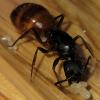I can feel it, that colony's gonna explode into a great empire of beautiful ants. ![]()
![]()
- Formiculture.com
- Forums
- Gallery
- Members
- Member Map
- Chat

I can feel it, that colony's gonna explode into a great empire of beautiful ants. ![]()
![]()
Not a great picture, but here is the C. maccooki worker.
The best part of keeping ants is when the first workers show up. The amount of happiness and joy you feel when you first realize that you're queen has successfully raised a colony is hard to beat.
Yes, it's quite nice. Especially when it's not a commonly kept species. ![]()
I can feel it, that colony's gonna explode into a great empire of beautiful ants.

Thank you. I'll try my best to have that happen. ![]()
All of the P. californicus have eggs besides three queens, one also died.
Here is a couple better pictures of the C. sp. worker.
Edited by ReignofRage, July 1 2021 - 3:20 PM.
June 24th
C. anthrax - Two small larvae and one egg.
C. clarithorax - Three colonies, including thee unusually small queen, have workers.
C. essigi - Up to four workers now.
C. hyatti - Both colonies have four workers each.
C. sp. - Now has three workers and another that should enclose soon.
C. maritimus - Still just larvae.
C. semitestaceus (desert) - Four workers
C. us-ca02 - One colony has six workers and the second has eight workers.
C. vicinus (low-elevation) - Eight workers and a lot of brood.
L. occidentale - One colony has 45+ workers, the other has 10 workers and a ton of brood. These are also the last pictures before I send them to CalTech.
Myrmecocystus Erem. sp. - Still no workers, but one of the cocoons looks ready.
V. pergandei - Five workers and new batch of eggs.
Edited by ReignofRage, June 26 2021 - 5:05 PM.
Got some stuff from TheAntGuy when I went anting with him.





S. xyloni - big egg pile.
Oh and also I got a winged, infertile C. clarithorax.
Edited by ReignofRage, July 5 2021 - 11:29 PM.
The P. californicus (bicolor) queen ate the two brood she had, hopefully she gets more.
July 1st

C. anthrax - The three larvae are continuing to develope.

C. clarithorax - All colonies have two or more workers.

C. essigi - Five workers now and a cocoon that is close to enclosing.

C. hyatti - Four or Five workers with a nice brood pile.

C. sp. - Up to five workers now and a nice 13 egg and larvae second generation.

C. maritimus - Still with just larvae.

C. sayi - A new callow worker.

C. semitestaceus (desert var.) - Four workers and some developing brood.

C. us-ca02 - After inspecting the scattered eggs last time, I relaized that they were developed and I actually saw a lavae! Since this queen is missing everything past her scapes I decided to give her a worker from another colony in hopes that the worker will take care of the brood.

C. vicinus (low-elevation var.) - Eight workers and a lot of brood.

Myrmecocystus Eremnocystus sp. - So this queen never opened it's cocon, when I did the worker was fully developed and dead. I plan on either finding or receiving a couple workers to give to her.

P. californicus (bicolor var.) - Still no brood yet.

P. californicus (concolor var.) - All queens have a large egg pile.

S. xyloni - Still just a massive brood pile.

V. pergandei - Six of Seven workers and a nice amount of larvae.
Edited by ReignofRage, July 5 2021 - 11:29 PM.
The P. californicus bicolor queen never got brood again and died.
Finally got a microscope and the time to key the Myrmecocystus Eremnocystus queen, turned out to be M. creightoni.
July 8th
I've decided to focus on the species I mainly want to keep long-term. If anyone wants to see pictures of other species just let me know.

C. anthrax - The three larvae have continued to develope.


C. essigi - Seven workers now.

C. maritimus - Now has a couple pupae.

C. sayi - Three workers and a small brood pile.


C. sp. - Six workers and some brood.


C. us-ca02 - This queen's eggs are starting to turn into larvae, after these become workers this colony should take off.


M. creightoni - She has started to lay some more eggs, too bad she doesn't care much for her brood. I hopefully will be able to either get a couple workers from someone or hope she makes some more pupae and I can open them. Tips on knowing when to open cocoons are appreciated.
Edited by ReignofRage, July 8 2021 - 7:26 AM.
It still looks very undersized, but I'm wondering if the larva on the very left is on its way to becoming a naked pupa.
Website: https://sites.google...home?authuser=0
Instagram: https://www.instagra.../bay.area.ants/
Youtube Channel: https://www.youtube....5Mh2eBAviuO2uw?
It still looks very undersized, but I'm wondering if the larva on the very left is on its way to becoming a naked pupa.
Possibly, the one next to it is quite larger. She made up to, I want to say five cocoons; all of which disapeared besides two. I opened the first single cocoon prematurely and the second one way too late. I kind of hope they become naked pupae because then she'll get workers on her own. ![]()
congrats on the seven C. essigi workers, its cool that you can kind of see through the segments of their gastors. Can't wait to see them grow!
Nylanderia parvula - 4 queen polygynous colony with larvae + devoloping workers
Camponotus pennsylvanicus - 1 queen with 2 cocoons, and a few larvae and eggs
Tetramorium immigrans - 3 colonies, first nanetics!
Formica pallidifulva - 1 queen, 8-10 eggs
Tetramorium atratulum - 1 queen with roughly 17 host workers
![]() Pheidole pilifera - 1 queen! recently caught!
Pheidole pilifera - 1 queen! recently caught! ![]()
Solenopsis Molesta - 2 queens so far, polygenous set-up
---------------------------------------------------
My Ant Journal - yibsi’s Wonderful Ant Keeping Journal 5-22-21 - Ant Keeping Journals - Ants & Myrmecology Forum (formiculture.com)
My T. Atratulum Journal - https://www.formicul...ontinued/page-2
congrats on the seven C. essigi workers, its cool that you can kind of see through the segments of their gastors. Can't wait to see them grow!
Thank you! I like how physogastirc ants look, it's very cool to see through the membrane.
July 14th


C. anthrax - Still just three developing larvae, moved her to a new tes tube so pictures wouldn't be so blurry from the dried cotton.



C. essigi - They now have eight workers, the worker enclosed earlier today.


C. sp. - Still at six workers, the seventh is going to enclose in the next few days.

C. maritimus - There is now three cocoons, just a couple weeks 'til workers.

C. sayi - still at three workers, but there is new eggs.


C. us-ca02 - Still just the queen and inoculated worker, but most of the 25+ eggs are now larvae. It's going to be nice having a large first generation.


M. creightoni - So, in the first picture th queen is holding a dead larva. The second picture shows two of the naked pupae, the center-shot one, I think will enclose bad because it has curled a bit whereas the other is staying in perfect shape.
I forgot to say that the other colonies I have are doing great. All the P. californicus (concolor) and the single S. xyloni have larvae and/or pupae; the though-to-be-dud C. vicinus (low-elevation) queen has larvae as well.



Here's pictures of some of the other colonies, C. clarithorax, C. vicinus low-elevation var., and P. californicus concolor var.
Ant Keeping →
Ant Keeping Journals →
Temnothorax's Myrmecocystus Testaceus JournalStarted by Temno , May 28 2025 |
|

|
||
Ant Keeping →
Ant Keeping Journals →
Zhuge's Pogonomyrmex occidentalisStarted by Zhuge , Mar 17 2025 |
|

|
||
Market Place →
General Market Place →
looking for pheidole megacephala (CA)Started by AsdinAnts , Dec 28 2024 |
|

|
||
Anting →
Ant ID Requests →
Pheidole from The Ant VaultStarted by AsdinAnts , Nov 6 2024 |
|

|
||
Ant Keeping →
Ant Keeping Journals →
AntsCali's Awesome Aphaenogaster megommataStarted by AntsCali098 , Oct 10 2023 |
|

|
0 members, 1 guests, 0 anonymous users